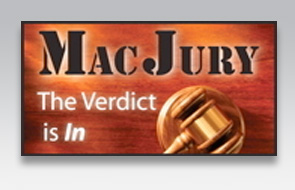 I took part in another session of The MacJury, Chuck Joiner’s excellent panel-based podcast. This time out, we talked about our favorite tips, features and accessories for the iPhone — particularly for the new iPhone 3GS and 3.0 software. These are always lots of fun to do, and entertaining to listen to (I hope.) On this session were Steve Sande from The Unauthorized Apple Weblog, Pat Fauquet of MacMouseCalls, author Tom Negrino and my Mac Observer compatriot Jeff Gamet. If you’re a reader of this site, I hope you’re also a subscriber to this podcast — it’s always a good discussion, whether I’m a participant or not.
I took part in another session of The MacJury, Chuck Joiner’s excellent panel-based podcast. This time out, we talked about our favorite tips, features and accessories for the iPhone — particularly for the new iPhone 3GS and 3.0 software. These are always lots of fun to do, and entertaining to listen to (I hope.) On this session were Steve Sande from The Unauthorized Apple Weblog, Pat Fauquet of MacMouseCalls, author Tom Negrino and my Mac Observer compatriot Jeff Gamet. If you’re a reader of this site, I hope you’re also a subscriber to this podcast — it’s always a good discussion, whether I’m a participant or not.
Category: iPhone/iPad
The ‘Every Other Year iPhone Club’
My wonderful family gave me a new iPhone 3GS for Father’s Day this year. It’s an amazing device that has enough improvements in speed and new features that it feels like as big a game-changer to me as the original iPhone. I wrote a short piece for The Mac Observer that explains why I thought this was a very compelling upgrade—at least for someone who had skipped the last one. [UPDATE: The article is now available on The MacObserver. If you feel so inclined, please leave a nice comment.]
Initial impressions of the iPhone 3GS
Oh. My. Goodness.
iPhone 3.0 discussed on MacJury
 The latest installment of Chuck Joiner’s MacJury podcast is up. In it, I take part in a great panel discussion with a stellar lineup of “jurors:” Macworld’s Peter Cohen, Tonya Engst of TidBITs and Take Control, John Braun of The Mac Observer, Don McAllister of Screencasts Online and Adobe’s Terry White.
The latest installment of Chuck Joiner’s MacJury podcast is up. In it, I take part in a great panel discussion with a stellar lineup of “jurors:” Macworld’s Peter Cohen, Tonya Engst of TidBITs and Take Control, John Braun of The Mac Observer, Don McAllister of Screencasts Online and Adobe’s Terry White.
It’s a lively hour’s worth of talk about what’s in the update, what’s not and a little digging into what’s important and why. Panels this large can tend to get a little unwieldy, but thanks to Chuck Joiner’s expert choreography and the terrific panelists, the result is a spirited, friendly and fun discussion.
If you don’t already subscribe to the MacJury podcast, you should. It’s a consistently relevant, interesting and entertaining look at the issues surrounding Apple and the Macintosh.
Apple’s iPhone 3.0 update: the good, the bad and the still missing
 Apple held its iPhone 3.0 event today and unveiled a slew of new features, but no real surprises. Cut and paste is finally here, Flash is still not, and Push Notifications are apparently here for real this time.
Apple held its iPhone 3.0 event today and unveiled a slew of new features, but no real surprises. Cut and paste is finally here, Flash is still not, and Push Notifications are apparently here for real this time.
Perhaps the biggest news — or at least the news with the most far-reaching consequences — is related to commerce. The iApp store will now have support for “in-App” purchases along with subscriptions. That means you can buy new furniture within The Sims, buy new books within an eReader app, or subscribe to a magazine or online financial service. The “one-and-done” method of purchasing iPhone apps could well be over. As I “semi-live-Tweeted” the event, I called iPhone 3.0 the “Monetization” update and noted that it would be interesting to see how the inevitable attempts by developers to “nickel and dime” the iApp buying process would fly in the face of the existing 99¢ per app mentality that seems to be dominating the market.
What I’m hoping for in the iPhone 3.0 software
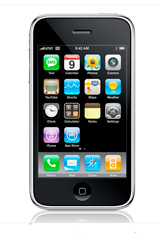 If you’re reading this, it should come as no surprise whatsoever that I’m eagerly anticipating tomorrow’s Apple event where they’ll describe the upcoming 3.0 update to the iPhone software.
If you’re reading this, it should come as no surprise whatsoever that I’m eagerly anticipating tomorrow’s Apple event where they’ll describe the upcoming 3.0 update to the iPhone software.
Here are a few of the things I’ll be looking for:
‘The company formerly known as a computer maker’
Apple’s latest financial results call was an interesting one on several fronts. Indeed, I think it may be looked upon years from now as a milestone in the company’s history.
Why? Mainly, because it marks a clear point in time where the company stopped being a computer company and started being a consumer device maker. As Steve Jobs pointed out in a recent keynote, Apple is a company that stands on a three-legged stool. Macs — computers — are obviously one leg; iPods a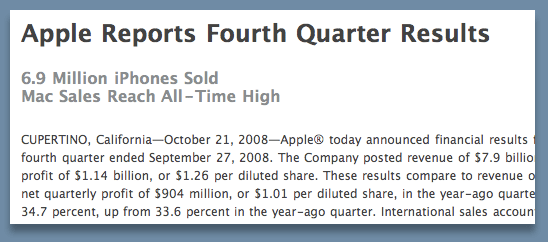 re the second; and now, iPhones make up the third leg of that stool. The analogy is an apt one. Apple’s not a computer company that makes iPods and iPhones as a side business: the three-legs more or less equally support the company. As Apple reported, iPhones made up 39% of Apple’s business (using the non-GAAP figures — we’ll get into that in a minute.) That’s an astonishing statistic. In just 15 months, the iPhone has become the biggest single contributor to Apple’s bottom line, with lots of room to grow. iPods account for 31% and Macs themselves make up the smallest portion of revenue at 30%.
re the second; and now, iPhones make up the third leg of that stool. The analogy is an apt one. Apple’s not a computer company that makes iPods and iPhones as a side business: the three-legs more or less equally support the company. As Apple reported, iPhones made up 39% of Apple’s business (using the non-GAAP figures — we’ll get into that in a minute.) That’s an astonishing statistic. In just 15 months, the iPhone has become the biggest single contributor to Apple’s bottom line, with lots of room to grow. iPods account for 31% and Macs themselves make up the smallest portion of revenue at 30%.
A brief word on GAAP
A lot of Apple-watchers are getting a quick lesson in economics over the company’s decision to use GAAP (Generally Accepted Accounting Principles) and book the revenue generated from its iPhones (and Apple TV’s) using a subscription method. That means that rather than booking the entire revenue generated from a sale in the period in which the sale was made, Apple spreads out the value of the sale over 24 months. In its interpretation of the rules, Apple believes that method allows it to provide free software updates over the course of those two years, rather than having to set a value for them. That’s why iPod touch owners have to pay for the updates that iPhone owners get for free. The company doesn’t make more of less money using either method; it just gets counted differently. So, if the revenue generated by iPhone and Apple TV sales did not have to get spread over two years, Apple’s results would be even higher. That’s why the company also reported what its results would be under non-GAAP accounting. As Jobs said in the call, the iPhone story was “too big for Apple management or investors to ignore.”
So, adjusting for non-GAAP reporting, take a look at Apple’s performance in the fourth quarter over the past three years.
Fourth Quarter Revenue (non-GAAP)
- 2006: $4.84 billion
- 2007: $6.22 billion
- 2008: $11.68 billion
The growth is stunning and illustrates a truly transformation period in the company’s history.
Wither the Mac?
I think this is wonderful news for that first leg of the stool, the Macintosh. It gives Apple a lot more breathing room than if it remained primarily a computer company. The diversity brought by the iPod and iPhone is insulating. It means Apple does not have to have a huge hit with every computer product. It means it has the luxury of being innovative, of spending money on R&D (Forget not, either, that the company has no debt and cash on hand of $25 billion — an increase of almost $10 billion since just last year.) And let’s not forget that much of the innovation on the other two legs of the stool begins or is to some extent reliant on what Apple does to the Mac. It’s a symbiotic product mix that I think Apple views in a holistic way, so I don’t see the Mac going away any time soon.
A few other notes
Steve Jobs couldn’t resist delivering the news in person that Apple outsold BlackBerry maker RIM in this quarter, and that by revenue, Apple is now the third-largest mobile phone seller in the world — again, in just 15 months in the market.
Rumor mongers will point to the fact that Jobs was on the call as some sort of sign regarding his health. The truth is that Steve does occasionally take part in these calls — though not often. I think he was there primarily to crow about the success of the iPhone and the fact that the 10 million unit goal for 2008 was reached two months early; and to talk to analysts about the uncertainty of the economy over the next period and its potential impact on Apple.
I’ll be on a MacJury podcast panel later this week to talk more about the conference call and other Apple matters. Visit the MacJury webpage or check back here for a link when the show is posted.
Podcaster rejection: Apple can, but shouldn’t
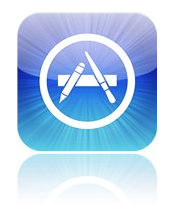 At first glance, it seems like another typical Mac tempest in a teacup — a “helpless indie developer being ridden roughshod by the big bad monolithic control freak Apple.” Like Macworld media blacklisting and the Proteron LiteSwitch and Konfabulator incidents before it, it’s a cause celebre that unifies the Mac web, but makes them look petty and childish once the sobering light of scrutiny is shone upon it.
At first glance, it seems like another typical Mac tempest in a teacup — a “helpless indie developer being ridden roughshod by the big bad monolithic control freak Apple.” Like Macworld media blacklisting and the Proteron LiteSwitch and Konfabulator incidents before it, it’s a cause celebre that unifies the Mac web, but makes them look petty and childish once the sobering light of scrutiny is shone upon it.
[The rest of this article appears on The Mac Observer/iPodObserver. Please click here to read it. –Ed.]
MacJury: ‘Re-ordering Apple’s iPhone priorities’
 In what may be the most pretentiously titled session yet, I joined a great panel of Mac and technology pundits for the latest installment of Chuck Joiner’s MacJury podcast. We discussed Apple’s financials for a bit, then launched into our thoughts on what should be next on the feature list of the iPhone. (Voice dialing was a unanimous choice.)
In what may be the most pretentiously titled session yet, I joined a great panel of Mac and technology pundits for the latest installment of Chuck Joiner’s MacJury podcast. We discussed Apple’s financials for a bit, then launched into our thoughts on what should be next on the feature list of the iPhone. (Voice dialing was a unanimous choice.)
Please forgive some of the choppiness of the audio — we had Skype issues throughout the taping, none of which were helped by the fact that I was connecting from a Boy Scout camp in rural Pennsylvania.
It was a lively and typically fun session. I think the MacJury has found its voice with its lighthearted tone and the occasional joke interspersed with the punditry. This session’s panel was a pleasure to be with, and along with host Chuck Joiner, included Jeff Gamet, Galen Gruman and Terry White.
Yet another reason not to use my regular phone
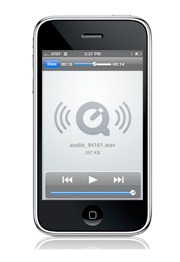 I use a VoIP service from AT&T called CallVantage for my home phone. One of the services features is that it sends voicemail as a .wav attachment to my email address. Unfortunately, my iPhone could never play the type of .wav the service creates, meaning I could see that I had a voice message, but I couldn’t listen to it. (Yes, I could dial in to my voicemail, but I can never remember how.)
I use a VoIP service from AT&T called CallVantage for my home phone. One of the services features is that it sends voicemail as a .wav attachment to my email address. Unfortunately, my iPhone could never play the type of .wav the service creates, meaning I could see that I had a voice message, but I couldn’t listen to it. (Yes, I could dial in to my voicemail, but I can never remember how.)
Last night, I discovered that the iPhone 2.0 update fixed the issue and the files play perfectly. My short list of missing iPhone features is getting shorter and shorter (and yes — cut-and-paste is still number one.)